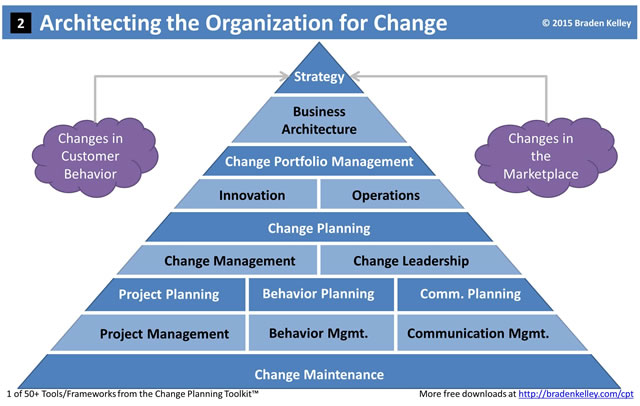 In my last article and the first free download from the Change Planning Toolkit™ on The Five Keys to Successful Change™ we looked at the five different disciplines that must come together to make any organizational change effort (or even a project) successful. They included:
In my last article and the first free download from the Change Planning Toolkit™ on The Five Keys to Successful Change™ we looked at the five different disciplines that must come together to make any organizational change effort (or even a project) successful. They included:
- Change Planning
- Change Leadership
- Change Management
- Change Maintenance
- Change Portfolio Management
While most people would agree that change is a constant, it is not however a constant focus for the business. One of the reasons many organizations are so bad at change is that they are not architected for change and pay attention to only one or two of The Five Keys to Successful Change™. Instead most organizations focus on executing the day-to-day business and they focus on executing a portfolio of projects, hopefully on time and on budget. In some cases, projects may incorporate some elements of Change Management (usually too late in the process) and ignore Change Planning, Change Leadership, Change Maintenance, and Change Portfolio Management.
As a result, most organizations are terrible at change. And ultimately, most organizations are bad at innovation because they’re bad at change.
Most companies focus on delivering a set of new systems, products, and services prioritized purely on the ROI they may return, instead of consciously executing ‘Big C change efforts’ and ‘Little C change projects’ to support a constantly evolving business architecture that changes in support of a fluid strategy driven by constantly changing customer behaviors (including wants/needs), regulation and competition, and influencing changes in employee, supplier, and partner behaviors. Continuous improvement and innovation then are effectively tools used to keep the organization successfully aligned to maintain the optimum levels of competitiveness and customer connection.
In this article we will explore some of the ways that organizations need to re-think the way that the firm is structured, in order to place change purposefully at the center, enabling enable increases in organizational agility and the building of continuous change capabilities.
Architecting the Organization for Change helps organizations:
- Visualize a new way to increase organizational agility
- Integrate changes in the marketplace and customer behavior into the strategy
- Create a new organizational architecture that integrates all five elements of organizational change
- Make project, behavior and communications planning and management a central component of your change efforts
One thing that should immediately jump out as you look at the image of the Change Planning Toolkit™ download titled Architecting the Organization for Change, is that The Five Keys to Successful Change™ are embedded in the framework.
Change Maintenance forms the foundation of a change-centric organization, ensuring that the changes necessary to ensure a healthy firm continue to persist (or are “maintained”), while the top of the organizational pyramid is driven by a conscious strategy that evolves over time, informed by changes in customer behavior and changes in the marketplace.
The strategy of the firm then determines the appropriate business architecture, and as the organization’s strategy changes, the business architecture may also need to change. Any necessary changes in the architecture of the business (new or updated capabilities or competencies) then will lead to modifications to the portfolio of change initiatives and projects (and remember every project is a change effort). These projects and initiatives will consist of innovation initiatives and efforts to create positive changes in the operations of the business.
The change efforts and projects identified as necessary and invested in as part of the change portfolio then represent projects that impact the innovation and operations for the firm, and in order to successfully execute them in the short term includes change planning, management, and leadership, and in the longer term the maintenance of the required changes.
And for the change efforts and projects to be successful the organization must also focus on project planning and management, behavior planning and management, and communications planning and management. The related projects, behaviors, and communications must all be effectively planned and managed in a way that keeps all three in sync.
I hope you see that by increasing your focus on the Change Planning discipline and increased use of the Change Planning Toolkit™ and tools like the Architecting the Organization for Change framework will allow businesses to more collaboratively and visually plan each change effort and prepare the plans for the Change Management and Change Leadership teams to execute with help from the Project Planning, Project Management, and Change Maintenance professionals in the organization.
I hope you’ll come join me on this journey to improve the pace and execution of change efforts in our organizations!
Sign up for Change Planning Toolkit™ launch updates
Click to access this framework as a scalable 11″x17″ PDF download
![]() Sign up here to get Human-Centered Change & Innovation Weekly delivered to your inbox every week.
Sign up here to get Human-Centered Change & Innovation Weekly delivered to your inbox every week.


Pingback: Innovation Excellence | Architecting the Organization for Change
Pingback: Digital Transformation versus Digital Strategy | Organizational Agility for Innovation & Change
Pingback: Digital Strategy Vs. Digital Transformation
Pingback: 13 Change Management Experts Share Their Tips | Organizational Agility for Innovation & Change
Pingback: 10 Free Change Planning Tools | Human-Centered Change and Innovation